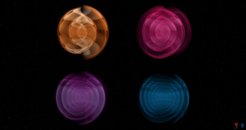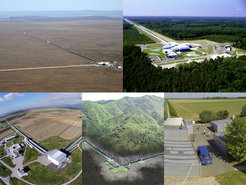Gravitational-wave detectors start next observing run to explore the secrets of the Universe
Today the LIGO-Virgo-KAGRA (LVK) Collaboration begins a new observing run with upgraded instruments, new and even more accurate signal models, and more advanced data analysis methods. The LVK collaboration consists of scientists across the globe who use a network of observatories—LIGO in the United States, Virgo in Europe, and KAGRA in Japan—to search for gravitational waves, or ripples in space-time, generated by colliding black holes and other extreme cosmic events. During the last years, researchers from the Max Planck Institute for Gravitational Physics in Potsdam and Hannover and the Leibniz University Hannover have prepared for this observing run by developing novel waveform models and data-analysis methods for extracting more information from the data, and by providing observational coverage.
This observing run, known as O4, promises to take gravitational-wave astronomy to the next level. O4 will begin on May 24th and last 20 months, including up to two months of commissioning breaks. It will be the most sensitive search yet for gravitational waves. LIGO will resume operations May 24th, while Virgo will join later in the year. KAGRA will join for one month, beginning May 24th, rejoining later in the run after some upgrades.
“Thanks to the work of more than a thousand people around the world over the last few years, we’ll get our deepest glimpse of the gravitational-wave Universe yet,” says Jess McIver, the Deputy Spokesperson for the LIGO Scientific Collaboration (LSC). “A greater reach means we will learn more about black holes and neutron stars and increases the chances we find something new. We’re very excited to see what’s out there.”
The Virgo detector will continue commissioning activities in order to increase its sensitivity before joining O4 later this year. “Over the past few months we have identified various noise sources and have made good progress in sensitivity, but it is not yet at its design goal,” declares recently elected Virgo spokesperson Gianluca Gemme. “We are convinced that achieving the best detector sensitivity is the best way to maximize its discovery potential.”
KAGRA is now running with the sensitivity planned for the beginning of O4. Jun'ichi Yokoyama, the chair of KAGRA Scientific Congress, says, “KAGRA is the first 2.5th generation detector in the world which started 20 years after LIGO. We will join O4 for one month and resume commissioning to further improve the sensitivity toward our first detection”.
Listening deeper into the Universe
With the detectors’ increased sensitivity O4 will observe a larger fraction of the Universe than previous observing runs. The LIGO detectors will begin O4 approximately 30% more sensitive than before. This increased sensitivity will result in a higher rate of observed gravitational-wave signals, resulting in a detection of a merger every 2 or 3 days. Additionally, the increased sensitivity will increase the ability to extract more physical information (including unique astrophysical and cosmological information) from the data. This increased signal fidelity will improve scientists’ ability to test Einstein’s theory of general relativity and infer the true population of dead stars in the local Universe.
Spin and orbital precession in the numerical simulation of a binary black hole merger
“The German-British gravitational-wave detector GEO600 has continued simultaneous observations and maintenance during the past three years while the other detectors were upgraded,” says Karsten Danzmann, director at the Max Planck Institute for Gravitational Physics (Albert Einstein Institute; AEI) and director of the Institute for Gravitational Physics at Leibniz University Hannover. “GEO600 will take part in O4 and will fill maintenance gaps from the other detectors while developing technologies for the future.” All large gravitational-wave detectors in the world now use technologies developed and tested at GEO600.
Learning more by using improved waveform models

“Thanks to the outstanding work of several postdocs and graduate students over the last few years, we have greatly improved the accuracy, efficiency and physical content of our waveform models. For the first time, we can extract black-hole properties in a few days, and, remarkably, in a few hours when using the novel machine-learning code DINGO,” says Alessandra Buonanno, director at the AEI in Potsdam. “With our new generation of waveform models, during O4 we will be able to identify black holes swirling space-time itself around and around at a fraction of the speed of light, emitting gravitational radiation across several harmonics.” A part of the department's high-throughput computing cluster Hypatia, with about 12,000 cores, will be made available to the LVK during O4 for analyses of gravitational-wave signals.
“We have prepared for O4 by developing new ways of using the most accurate signal models when analyzing the data. This will help us to better understand the black hole properties, their formation and fate,” says Frank Ohme, leader of an Independent Max Planck Research Group at AEI Hannover. “During O4, we will concentrate our efforts on the most exciting events: strongly spinning black hole binaries or systems where neutron stars are involved. We will extract as much astrophysics as possible, and help with analyses on our compute cluster ‘Holodeck’.”
The first gravitational-wave signals were detected in 2015. Two years later, LIGO and Virgo detected a merger of two neutron stars, which caused an explosion called a kilonova, subsequently observed by dozens of telescopes around the world. So far, the global network has detected more than 80 black hole mergers, two probable neutron star mergers and a few events that were most likely black holes merging with neutron stars. During O4, researchers expect to observe even more energetic cosmic events and gain new insights into the nature of the Universe.
As in previous observing runs, alerts about gravitational-wave detection candidates will be distributed publicly during O4. Information about how to receive and interpret public alerts is available at https://wiki.gw-astronomy.org/OpenLVEM.
Gravitational-wave observatories

LIGO is funded by the NSF, and operated by Caltech and MIT, which conceived and built the project. Financial support for the Advanced LIGO project was led by NSF with Germany (Max Planck Society), the U.K. (Science and Technology Facilities Council) and Australia (Australian Research Council) making significant commitments and contributions to the project. More than 1,500 scientists from around the world participate in the effort through the LIGO Scientific Collaboration, which includes the GEO Collaboration. Additional partners are listed at https://ligo.org/partners.php.
The Virgo Collaboration is currently composed of approximately 850 members from 143 institutions in 15 different (mainly European) countries. The European Gravitational Observatory (EGO) hosts the Virgo detector near Pisa in Italy, and is funded by Centre National de la Recherche Scientifique (CNRS) in France, the Istituto Nazionale di Fisica Nucleare (INFN) in Italy, and the National Institute for Subatomic Physics (Nikhef) in the Netherlands. A list of the Virgo Collaboration groups can be found at http://public.virgo-gw.eu/the-virgo-collaboration/. More information is available on the Virgo website at https://www.virgo-gw.eu.
KAGRA is the laser interferometer with 3 km arm-length in Kamioka, Gifu, Japan. The host institute is Institute for Cosmic Ray Research (ICRR), the University of Tokyo, and the project is co-hosted by National Astronomical Observatory of Japan (NAOJ) and High Energy Accelerator Research Organization (KEK). KAGRA collaboration is composed of over 480 members from 115 institutes in 17 countries/regions. KAGRA's information for general is at the website https://gwcenter.icrr.u-tokyo.ac.jp/en/. Resources for researchers are accessible from https://gwwiki.icrr.u-tokyo.ac.jp/JGWwiki/KAGRA.
Background information
Expected signals
The ‘bread and butter’ of gravitational-wave astronomers in O4 is expected to be signals from merging pairs of compact objects. As in the three previous runs, we expect the majority will be from binary black hole mergers, while the detection of coalescing binary neutron stars or black-hole–neutron-star pairs are expected to be much more rare. For each such signal, detailed astrophysical information about the systems and their orbits can potentially be extracted. Additional information can be obtained by combining multiple observations.
Increasing the sensitivity of the detectors by even a small amount has a big impact on how many signals we are able to observe. If we improve our detectors' sensitivity by just 25%, our searching volume of the Universe doubles. This means our detection rate will be approximately double, as well.
With increased sensitivity the observation of yet-to-be-detected types of gravitational-wave sources also becomes more likely. Continuous gravitational waves, for example from deformed rapidly rotating neutron stars are one such signal type. Another candidate is a gravitational-wave background which could be produced, e.g., by a very large number of individually unresolved signals.
More accurate modeling for extracting more information
Successful searches, correct identification of the sources, and precise inference of their astrophysical and cosmological properties require detailed knowledge of the expected waveforms. The increasing sensitivity of the detectors must be reflected in more accurate and more physically complete gravitational-wave models which should still be computationally efficient. Over the last years, ever more accurate waveform models and novel data-analysis methods have been developed, enabling the scientists to extract more information from the data. In particular, they improve in their accuracy of tracking spin precession and they increase the number of higher harmonics – all this while being several times faster than before. In order to cope with the expected large number of detections a new framework for rapid development and generation of new models was developed.














